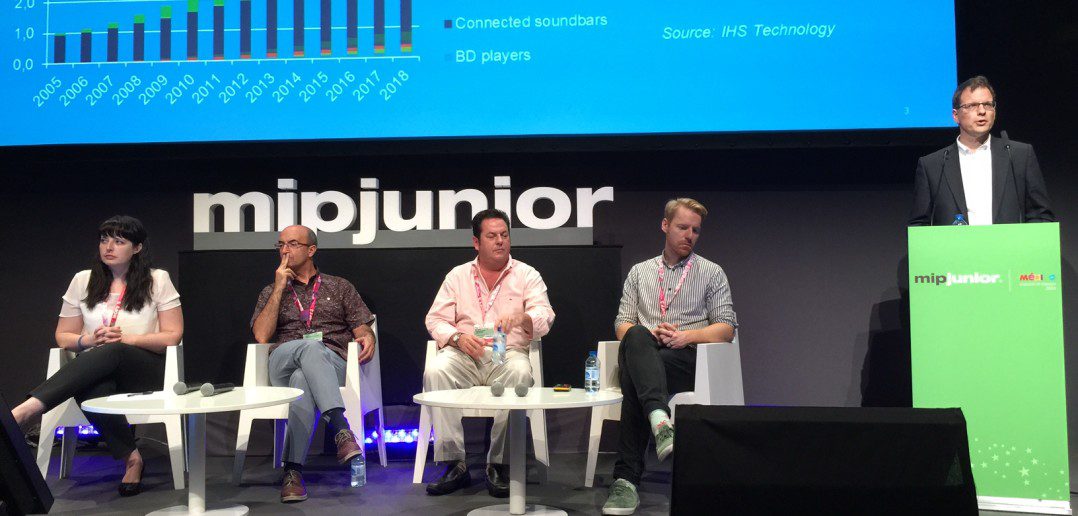No MIPJunior attendee will be shocked at the news that children are getting a growing share of their entertainment digitally on various devices. Just this week, the UK’s telecoms regulator Ofcom claimed that 34% of British 5-15 year-olds already own their own tablet, up from 19% just a year ago.
This is providing opportunities for traditional children’s TV producers and new digital startups alike, but it’s also presenting challenges: particularly around how to fund new forms of children’s entertainment, and how to get a good enough return on investment to continue experimenting with new formats and platforms.
A session at MIPJunior this morning explored these topics, introduced by Tim Westcott, principal analyst, TV at IHS Technology (right). The panel was moderated by Anna Stuart, analyst, TV programming at IHS, with speakers (left to right) Santiago Fandiño Lousa, head of children’s content at TVE in Spain; Christopher Keenan, VP of global production and content at HIT Entertainment; and Jonas Carlsson, VP brand and marketing for children’s apps maker Toca Boca.
« The world is changing as we know it, » said Westcott. « Most of us were in an environment where we were familiar with just one device: the television… Children obviously don’t have that, they have grown up in a world where there are multiple devices where they can see content. »
He pointed to six major countries where children’s TV viewing declined last year: the US, UK, France, Netherlands, Sweden and Germany, even though research suggests that children still watch more linear TV than any other content.
But Westcott also pointed to trends within the children’s TV market: the migration of children’s programming from generalist to specialist channels. Less Saturday-morning and teatime shows on mainstream channels, and more branded children’s channels – particularly now in the digital TV world.
Westcott talked about tough times for children’s TV, and outlined some results from a survey of producers and broadcasters in 28 countries conducted by IHS this year. Among the findings: 58% of producers still get upfront funding for their children’s shows from broadcasters; more than half the broadcasters surveyed spend a majority of their budget on original programming, with 20% spending more than 75% on it; and 63% of producers expect broadcaster budgets to decline in the coming years, with only 9% thinking they’ll increase.
Broadcasters and producers are making shows available to stream online, but it’s still early days. « People are not seeing a great deal of revenue from digital, and certainly not enough to compensate from any decline they’re having from linear TV sales, » said Westcott.
Over to the panelists, with Lousa talking about how children are watching TV in Spain, noting that smartphone and tablet apps « are the key », well ahead of websites and smart TV applications.
Meanwhile, Toca Boca’s Carlsson talked about his company’s role as a « digital play studio », with 75m downloads so far of its apps: « The second largest publisher in the kids category on the App Store, after a small company called Disney! » Carlsson said that when Toca Boca started, there were a lot of education apps and a lot of games available for children, but not so much in between: toys for digital play. « We don’t tell the story: the kids who play the app will tell the story, » he said.
Moderator Stuart asked the panel whether the claims of a linear TV decline are correct? « With kids, we are in a very special moment. Things are changing year by year, » said Lousa. « In the studies we made with kids, we understand one thing… You offer them the content, and put them as near as you can, and as available as you can. They don’t understand that they must wait for something. They need it, and they need it now. »
Keenan talked about children’s ability to find and spend time with characters « regardless of the platform… very often for us, second screens for our audience are often their first screens, and that’s the first time they’re introduced to our characters and our worlds… We’re in and on every possible stream with all of our characters. »
The panel was asked about online video, with Lousa saying TVE is putting a lot of effort into the area, recognising that video is its strength, much more than something like games. Instead, it looks to strike partnerships with companies who are strong in those other areas. HIT Entertainment is also working on creating content around some of its key brands – Thomas & Friends in particular – for online formats: shortform video, for example, or « audience-inspired storytelling », according to Keenan.
What about video from Toca Boca? « We don’t do video content, » said Carlsson, who noted that the company does shoot trailer and demonstration videos, which on YouTube attract hundreds of thousands of views – but it’s still marketing-focused, rather than a move into original TV-style content.
Lousa praised app and games companies for being « smarter » on the subject of how children are using devices, and the usability of the apps that they’re using, suggesting that the TV industry is having to catch up quickly with this knowledge. « We are trying to understand, » he said.
Carlsson was asked about licensing and consumer products, and he noted that Angry Birds has been a huge success, but there are many other examples of apps companies failing to meet expectations with their moves into merchandise, which is why Toca Boca is cautious. « It’s still something we’re exploring… it’s an experimental phase, » he said.




